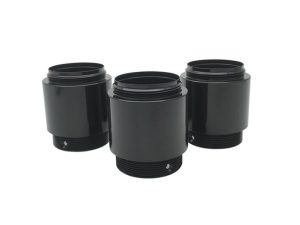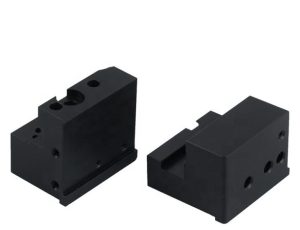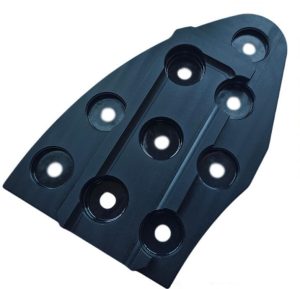What is Black Oxide Coating? Everything You Need to Know
In CNC machining and metal fabrication, the final finish of a part can be just as crucial as its dimensions and tolerances. A finish affects the part’s visual appeal, functionality, and longevity. That’s where black oxide coating comes into play.
Black oxide coating, in essence, is a thin protective layer applied to metal parts to improve their corrosion resistance and minimize light reflection. This process, also known as blackening, involves a chemical reaction between the iron on the metal surface and the black oxide solution, forming magnetite (Fe3O4) on the part’s surface. The beauty of black oxide lies in its ability to provide a matte black finish, enhancing the aesthetic appeal of metal parts while offering a degree of protection.
Now, why should you keep reading? Understanding the intricacies of black oxide coating could be the key to unlocking a new level of quality and durability in your products.

What Is Black Oxide Coating and How Is It Applied?
At its core, black oxide coating is not merely a layer applied to the surface of a metal; it’s a chemical reaction that fundamentally changes the metal’s surface to produce a layer of magnetite (Fe3O4), black iron oxide. This isn’t painting or plating – it’s transformation. The result is a sleek, matte black finish that’s as functional as beautiful.
The Application Process: A Symphony of Precision
Applying black oxide coating is akin to conducting an orchestra, where each instrument must play in perfect harmony. The process typically involves several key steps:
- Cleaning: First, the metal must be immaculately cleaned to remove any oils, grease, or impurities. This ensures that the coating will be uniform and adhere properly.
- Preparation: The metal is then dipped into a series of baths to prepare its surface. This might involve a pickling process to remove any rust or scale.
- The Black Oxide Bath: This is where the magic happens. The prepared metal is submerged in a black oxide solution, usually around 285°F (140°C) for steel. The solution triggers a chemical reaction that forms the black iron oxide layer.
- Post-Treatment: After the coating is applied, the metal is usually treated with a sealing solution, such as oil or wax, to enhance the corrosion protection and give it a more appealing finish.
- Drying: Finally, the treated parts are dried. The result is a durable, corrosion-resistant finish that can withstand the rigors of industrial use while providing a visually appealing surface.
What Materials Can Be Treated with Black Oxide?
Ferrous Metals

The main stars of the black oxide coating show are ferrous metals. This includes:
- Steel: The most common material treated with black oxide. Both carbon steel and alloy steel are excellent candidates for this type of coating. Steel’s composition allows for a uniform and durable black oxide layer, enhancing its corrosion resistance and aesthetic appeal.
- Stainless Steel: Yes, the stainless variety also gets along famously with black oxide. The process for stainless steel involves a pre-treatment that prepares the surface, ensuring the coating adheres well and provides the desired protection and look.
- Cast Iron: Good old cast iron, with its high carbon content, is another material that benefits from black oxide coating. The process gives cast iron parts a protective layer, reducing the risk of rust and giving them a more refined finish.
Non-Ferrous Metals
It’s important to mention that while black oxide coating is predominantly used for ferrous metals, specialized treatments are available for certain non-ferrous metals. These are not the standard black oxide processes and often involve additional steps or different chemicals to achieve a similar appearance. For instance:
- Copper and Brass: While traditional black oxide is unsuitable for these materials, alternative processes are designed to give copper and brass a blackened finish. These processes are distinct from black oxide but aim to achieve a similar aesthetic result.
- Aluminum: Similar to copper and brass, aluminum requires specialized treatment for a black appearance. This is often called “black anodizing” rather than black oxide and involves an electrochemical process.
What Are the Key Benefits of Using Black Oxide Coating?
Enhanced Corrosion Resistance
One of the primary advantages of black oxide coating is its ability to impart improved corrosion resistance to metal parts. While it may not create an impervious shield like some heavy-duty coatings, it significantly reduces the metal’s susceptibility to rust and corrosion. This is particularly beneficial in environments where moisture is a constant adversary. Think of it as a knight’s armor, not impenetrable but formidable enough to fend off many foes.
Minimal Dimensional Impact
For applications where precision is paramount, black oxide coating shines brightly. Unlike plating or painting, the black oxide process adds a negligible thickness to the metal—usually no more than a few microns. This means that components can retain their precise dimensions and tolerances, ensuring they fit and function as intended without needing post-coating adjustments. It’s the equivalent of a perfectly tailored suit; it enhances without altering the essentials.
Reduced Glare and Light Reflection
The matte black finish of black oxide-coated parts isn’t just about aesthetics; it serves a practical purpose by reducing glare and light reflection. This is especially valuable in tools, instruments, and components used in optical and shooting equipment, where glare can be a distraction or even a hazard. It’s like having sunglasses for your metal parts, providing comfort and visibility when it matters most.
Improved Lubrication and Reduced Friction
Another noteworthy benefit of black oxide coating is its ability to retain lubricants on the surface of the metal. When sealed with oil or wax, the black oxide finish creates a surface that facilitates lubrication, reducing friction and wear over time. This is crucial for moving parts and machinery, where friction is the enemy of efficiency and longevity. It resembles a smooth dance floor, allowing for graceful, effortless movement.
Aesthetic Appeal
Beyond its functional advantages, black oxide coating offers a distinctive, elegant aesthetic that can enhance the appearance of metal parts and products. The uniform, matte black finish can lend sophistication and quality to items, making them more appealing to consumers and users. The finishing touch can turn a simple object into a statement piece.
Types of Black Oxide Finish
Hot Black Oxide
Hot black oxide is the classic, commonly used black oxide finish method. It involves submerging the metal parts in a hot bath of sodium hydroxide, nitrates, and nitrites at temperatures around 285°F (140°C) to 295°F (146°C). This process produces an authentic black iron oxide magnetite finish, providing excellent corrosion resistance and minimal dimensional change.
It’s the go-to choice for a durable, wear-resistant coating on components that will face the rigors of use in industries ranging from automotive to firearms. Think of hot black oxide as the heavyweight champion in the black oxide family—robust, reliable, and ready for anything.
Mid-Temperature Black Oxide
Mid-temperature black oxide operates in the sweet spot between hot and cold processes, typically involving temperatures around 220°F to 245°F (104°C to 118°C). This process offers a more environmentally friendly approach, reducing energy consumption and hazardous waste compared to the hot black oxide method.
The finish it produces is similar in appearance and corrosion resistance to hot black oxide but with the added benefits of being slightly gentler on the materials and more sustainable. Mid-temperature black oxide is like the middle child that strikes a balance, offering a compromise between performance and environmental considerations.
Cold Black Oxide
Ah, aluminum, the versatile and lightweight friend of manufacturers and artists alike. It engraves beautifully under a laser, creating a stark, white mark against its typically silver surface. Aluminum is particularly friendly for laser engraving, especially when anodized or treated, as it provides a high-contrast finish. Ideal for everything from industrial tags to bespoke artwork, it’s as versatile as it is easy to work with.
Stainless Steel
Stainless steel is like the stoic warrior of metals – resilient and reliable. Engraving on stainless steel requires a more potent laser setting due to its hardness and heat resistance, but the results are profoundly durable and corrosion-resistant.
This makes it perfect for medical tools, kitchenware, and outdoor applications where longevity is key. Using a marking compound can enhance the contrast and visibility of the engraving on stainless steel, making it durable and striking.
Brass and Copper

Cold black oxide is the quick and versatile sibling in the black oxide family. It’s applied at room temperature, using a brush-on or spray-on method, making it ideal for sizeable parts or those that cannot be heated due to material constraints. While cold black oxide offers a convenient and fast alternative, it’s important to note that the finish is typically more for aesthetics than for robust protection.
The corrosion resistance and durability are less than you’d get with hot or mid-temperature processes. Still, it’s perfect for projects where time is of the essence and appearance is critical. Cold black oxide is the sprinter of the group—fast and efficient but not quite as enduring as its longer-distance relatives.
Specialty Black Oxide for Stainless Steel
Stainless steel, with its unique properties, requires a special touch regarding black oxide finishes. This process involves a two-step chemical treatment that first activates the surface of the stainless steel to ensure proper adhesion of the oxide layer, followed by the actual blackening step.
The result is a sleek, durable finish that enhances the stainless steel’s natural corrosion resistance while providing the same aesthetic and functional benefits as black oxide on other metals. It’s the custom-tailored suit of the black oxide world—designed to perfectly fit the unique characteristics of stainless steel.
What Are the Industrial Applications of Black Oxide Coating?
Aerospace and Aviation
In the high-stakes world of aerospace and aviation, every component must meet stringent standards for performance and reliability. The black oxide coating is extensively used in this sector for parts that require minimal dimensional changes, high corrosion resistance, and reduced light reflection.
Components such as fasteners, gears, and fittings are commonly treated with black oxide to ensure they can withstand the demanding conditions of aerospace operations. It’s a testament to black oxide’s reliability when flying high is on the agenda.
Automotive Industry
The automotive industry relies on black oxide coating for functional and aesthetic purposes. Engine parts, tools, and fasteners benefit from the coating’s enhanced corrosion resistance and improved lubrication properties, contributing to longer life spans and better performance.
The sleek, matte black finish adds a touch of class to visible components, making it a popular choice for aftermarket accessories and performance parts. In automobiles, black oxide coating is a workhorse and a show pony.
Firearms and Defense
Durability and precision are non-negotiable in the firearms and defense industry, making black oxide coating a go-to solution. The coating’s ability to improve corrosion resistance and reduce glare is crucial for the performance and stealth of firearms and military equipment.
Moreover, the enhanced lubrication properties contribute to the smooth operation of moving parts, ensuring reliability when it matters most. In defense and firearms, black oxide coating is not just a finish; it’s a critical component of the overall design.
Tools and Hardware
From the humble wrench in your garage to the precision instruments used in manufacturing plants, tools, and hardware benefit immensely from black oxide coating. The corrosion resistance and improved grip the matte finish offers are critical advantages for tools that face regular use and exposure to harsh conditions.
Additionally, the aesthetic appeal of black oxide-coated tools sets them apart on the retail shelf, adding value to the brand and product. In tools and hardware, black oxide coating is both a protector and a beautifier.
Medical Devices
The medical device industry, with its stringent cleanliness and corrosion resistance requirements, also utilizes black oxide coating. Surgical tools, implants, and diagnostic equipment treated with black oxide benefit from their inert properties, ensuring they do not react adversely with the human body.
The coating also contributes to the durability and longevity of these critical instruments, ensuring they perform reliably in life-saving procedures. In the medical field, black oxide coating plays a pivotal role in form and function.
Consumer Goods
Beyond industrial applications, black oxide coating finds its way into various consumer goods, including sporting goods, electronics, and jewelry. The aesthetic appeal of the black matte finish, combined with the functional benefits of corrosion resistance and durability, makes it a popular choice for designers and manufacturers looking to differentiate their products in a competitive market. In consumer goods, black oxide coating adds a touch of elegance and quality that appeals to discerning customers.
Considerations of Black Oxide Finish
While black oxide coating offers many benefits, there are important considerations to keep in mind to ensure the success of the coating process and the finished product’s performance. Let’s delve into some of the critical factors that can influence the outcome of a black oxide finish.
Material Compatibility
The first consideration is the material of the component to be coated. As previously discussed, black oxide is predominantly used on ferrous materials, such as steel and iron. However, not all metals react similarly to the black oxide process, and the outcome can vary based on the material’s composition and properties. Unique formulations and methods are required for non-ferrous metals like stainless steel, highlighting the importance of understanding material compatibility.
Surface Preparation
The quality of the black oxide finish heavily depends on the condition of the metal surface before coating. Proper surface preparation, including cleaning and degreasing, is crucial to remove contaminants that could interfere with the chemical reaction required for the black oxide process. Inadequate preparation can lead to uneven coatings, poor adhesion, and reduced corrosion resistance, underscoring the need for meticulous preparation.
Environmental Conditions
Environmental factors, such as humidity and exposure to corrosive elements, can affect the durability and effectiveness of a black oxide coating. While black oxide enhances corrosion resistance, it is not impervious to all environmental conditions. In highly corrosive environments, additional protective measures, such as sealants or topcoats, may be necessary to extend the lifespan of the coating.
Post-Coating Treatment
The choice of sealant or post-coating treatment plays a significant role in the final properties of the black oxide finish. Options include oiling, waxing, or applying a clear topcoat to enhance corrosion resistance, reduce friction, or achieve a specific aesthetic. The intended application of the coated part should guide the selection of the most appropriate post-coating treatment.
Compliance and Regulations
Depending on the industry and application, specific compliance requirements and regulations may exist governing the use of black oxide coatings. This is particularly relevant in medical devices, aerospace, and defense sectors, where safety and performance standards are strictly regulated. Ensuring compliance with applicable standards is essential for successfully applying black oxide coatings in these sectors.
Cost-Effectiveness
Finally, the cost-effectiveness of implementing a black oxide coating should be considered. While black oxide is generally more cost-effective than some alternative finishes, the total cost can vary based on factors such as the parts’ complexity, production volume, and required post-coating treatments. Balancing the benefits of the coating with the associated costs is crucial for making an informed decision.
Conclusion
Black oxide coating offers a promising solution for manufacturers, engineers, and designers looking to improve their products with a durable and attractive finish. I encourage you to consider black oxide for your next project. Explore the possibilities, consult with specialists, and discover how this versatile coating can elevate your products.

